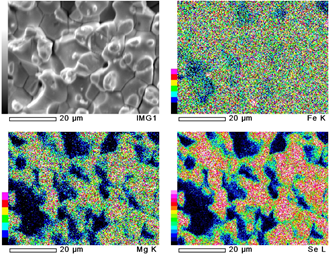Sintesis dan Analisis Penambahan Doping Magnesium (Mg) pada Material Superkonduktor FeSe dengan Metode Reaksi Padatan dalam Tabung Tertutup
Synthesis and Analysis of Magnesium-doped in FeSe Superconductor Materials with Solid-state Reaction Method in Sealed Tubes
DOI:
https://doi.org/10.25299/saintis.2019.vol19(2).3185Keywords:
Doping Magnesium, Reaksi Padatan, Sintering, Superkonduktor FeSe, Temperatur KritisAbstract
[ID] Ketergantungan manusia terhadap teknologi memasuki Revolusi Industri 4.0 sangat tinggi. Contoh penerapan inovasi di bidang teknologi informasi salah satunya adalah superkomputer dari material superkonduktor. Material superkonduktor identik dengan material non ferromagnetik karena sifatnya diamagnetis sempurna. Namun, sejak ditemukannya material superkonduktor berbasis logam ferromagnetik, penelitian terus dikembangkan, salah satunya material FeSe. Beberapa parameter yang perlu diperhatikan pada pembuatan material FeSe untuk memperoleh sifat superkonduktor terbaiknya diantaranya komposisi stoikiometri, penambahan doping, dan proses pembuatan material FeSe seperti proses pemaduan dan sintering. Dalam penelitian ini, pengaruh variasi doping Mg akan dianalisis terhadap sifat superkonduktor, morfologi, dan fasa yang terbentuk pada material superkonduktor FeSe. Material FeSe dibuat dengan metode reaksi padatan dalam tabung tertutup (Powder in Sealed Tube) secara insitu. Temperatur sintering yang digunakan 845⁰C yang ditahan selama 6 jam, dengan kenaikan temperatur 7⁰C/menit dari temperatur kamar, dan laju pendinginan normalizing. Kandidat material superkonduktor terbaik terdapat pada sampel Mg0.01Fe0.99Se. Didapatkan Temperatur kritis (Tc)onset = 15.42 K dan Tczero = 5.4 K. Morfologi sampel menunjukkan kristalisasi besar. Lalu, persentase fraksi volume fasa superkonduktornya juga merupakan yang terbesar yaitu 81.99%.
[EN] Human dependence on technology into the Industrial Revolution 4.0 is very high. Example, the application of innovations in information technology is supercomputer from superconducting materials. Superconducting materials are identical from non-ferromagnetic materials because tend perfectly diamagnetic. However, since ferromagnetic-metal-based superconducting material discovered, research continues to be developed, like FeSe material. Some parameters that need to be considered in making FeSe material to obtain the best superconductor properties include stoichiometric composition, doping addition, and process of making FeSe materials like synthesis and sintering treatment. In this study, the effect of Mg-doped variations will be analyzed towards properties of superconductors, morphology, and phases formed in FeSe superconducting materials. MgxFe1-xSe made by solid-state reaction method in sealed tube (Powder in Sealed Tube) “insituely”. The sintering temperature used 845⁰C which held for 6 hours, with 7⁰C/minute temperature rise from room-temperature and normalizing cooling rate used. The best candidate superconducting material came from Mg0.01Fe0.99Se, obtained critical temperature (Tc)onset = 15.42 K, and Tczero = 5.4 K. Sample morphology shows a large crystallization. Then, the percentage fraction of the superconducting phase was also the largest, which is 81.99%.
Downloads
References
[2] W. D. Callister dan D. G. Rethwisch, Materials Science and Engineering, 9 penyunt., New York: John Wiley and Sons, inc, 2014.
[3] Nurmalita, “The Effect of Pb Dopant on The Critical Temperature of BSCCO-2212 Superconducting Crystal,” Proceedings of The 2nd Annual International Conference Syiah Kuala University 2012, pp. 396-402, 2012.
[4] P. Hofmann, Solid State Physics, Edisi ke 2, Weinheim: Wiley-VCH, 2015.
[5] Y. Kamihara, T. Watanabe, M. Hirano dan H. Hosono, “Iron-Based Layered Superconductor La[O1-xFx]FeAs (x ) 0.05-0.12) with Tc = 26 K,” J. AM. Chem. Soc, vol. 130, no. 11, pp. 3296-3297, 2008.
[6] F.-C. Hsu, J.-Y. Luo, K.-W. Yeh, T.-K. Chen, T.-W. Huang, P. M. Wu, Y.-C. Lee, Y.-L. Huang, Y.-Y. Chu, D.-C. Yan dan M.-K. Wu, “Superconductivity in the PbO-type Structure α-FeSe,” PNAS, vol. 105, no. No. 38, pp. 14262-14264, 2008.
[7] Y. P. Dewi, Pengaruh Komposisi Pada Sifat Struktur dan Superkonduktivitas Fe(Se,Te) Dipreparasi dengan Metode Metalurgi Serbuk, Surabaya: Perpustakaan UNAIR, 2016.
[8] T. Mousavi, C. R. M. Grovenor dan S. Speller, “Structural Parameters Affecting Superconductivity in Iron Chalcogenides: a Review,” Materials Science and Technology, vol. 30, no. No. 15, pp. 1929-1943, 2014.
[9] Y. P. Dewi, Analisis Pengaruh Metode Pembuatan, Temperatur Sintering, dan Doping Carbon Nanotubes pada Mikrostruktur dan Superkonduktivitas MgB2, Surabaya: ITS, 2018.
[10] F. Lan, Z. Ma, Y. Liu, N. Chen, Q. Cai, H. Li, S. Barua, D. Patel, M. S. A. Hossain, J. H. Kim dan S. X. Dou, “The formation of nano-layered grains and their enhanced superconducting transition temperature in Mg-doped FeSe0,9 bulks,” Scientific Reports, pp. 1-5, 2014.
[11] G. Zhou, Q. Zhang, F. Zheng, D. Zhang, C. Liu, X. Wang, C.-L. Song, K. He, X.-C. Ma, L. Gu, P. Zhang, L. Wang dan Q.-K. Xue, “Interface enhanced superconductivity in monolayer FeSe films on MgO(001): charge transfer with atomic substitution,” Science Bulletin, pp. 1-19, 2018.
[12] R. Fitriandhani, Pengaruh Variasi Suhu Sintering dan Komposisi Stoikiometri Terhadap Pembentukan Fasa β-FeSe Melalui Pemaduan Mekanik dan Proses Reaksi Padatan, Jakarta: STT PLN, 2019.
[13] W. Qiu, Z. Ma, Y. Liu, M. S. A. Hossain, X. Wang, C. Cai dan S. X. Dou, “Tuning Superconductivity in FeSe Thin Films via Magnesium Doping,” ACS Applied Materials and Interfaces, vol. VIII, no. 12, pp. 7891-7896, 2016.

Downloads
Published
Issue
Section
License

This work is licensed under a Creative Commons Attribution-ShareAlike 4.0 International License.
Copyright. This is an open access article which means that all content is freely available without charge to the user or his/her institution. Jurnal Saintis allows the author(s) to hold the copyright without restriction. The copyright in the text of individual articles (including research articles, opinion articles, and abstracts) is the property of their respective authors distributed under the terms of the Creative Commons Attribution-ShareAlike 4.0 International License which permits unrestricted use, distribution, and reproduction in any medium. Users are allowed to read, download, copy, distribute, search, or link to full-text articles in this journal without asking by giving appropriate credit, provide a link to the license, and indicate if changes were made.





